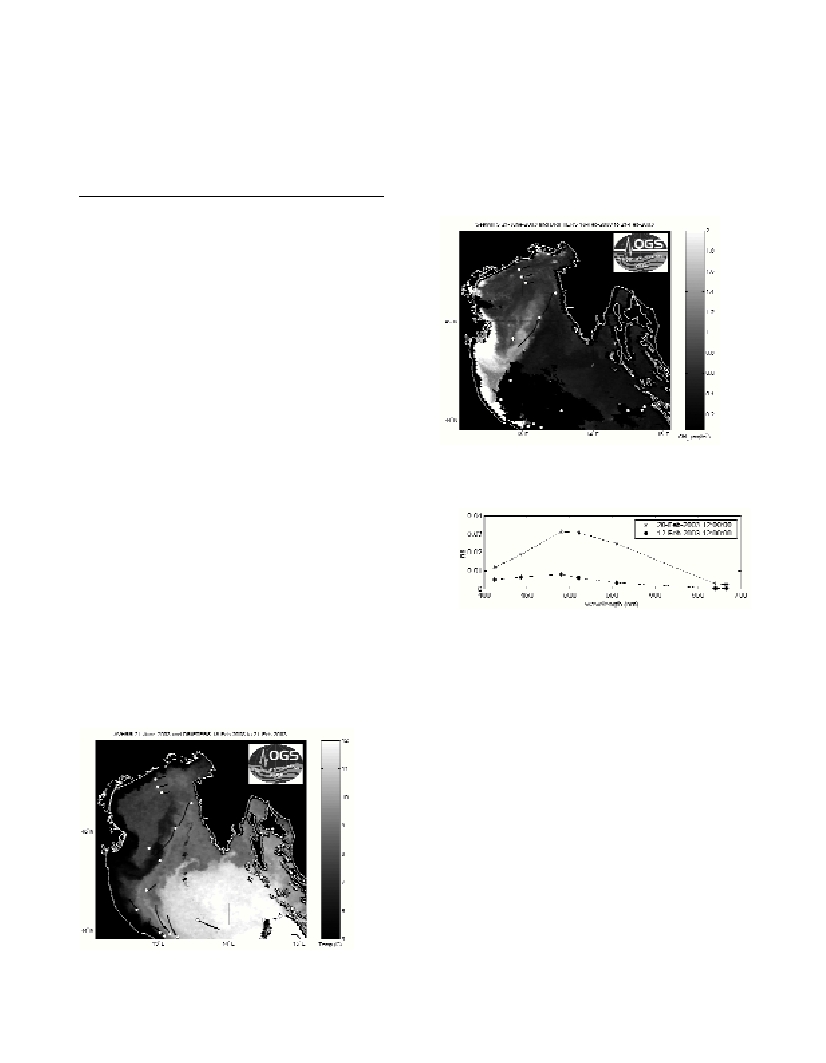Rapp. Comm. int. Mer Médit., 37,2004
124
EVOLUTION OF THE PO RIVER PLUME DURING FEBRUARY 2003
E. Mauri* and P.-M. Poulain
OGS, Borgo Grotta Gigante, 42/c Sgonico (Trieste), Italy - *emauri@ogs.trieste.it
Abstract
The Po River plume formation and evolution is studied using satellite images of sea surface temperature (SST) and ocean color, and drifter
data during February 2003. Medium Po River discharges combined with sustained strong episodes of bora winds triggered the
development of the plume extending to the northeast across the basin as the southern limb of a cyclonic gyre in the Northern Adriatic.
Key-words: River plume, drifters, satellite data, Adriatic Sea
Introduction
During strong bora events, the Po River plume generally extends
toward the Istrian Peninsula instead of going south in the West
Adriatic Current. In winter, this feature is visible both in temperature
and in chlorophyll due, respectively, to the lower temperature and
higher nutrients concentration of the river water compared to the
surrounding sea (1). The particular structure and evolution of the Po
River plume was studied using satellite and in situdata in February
2003 as part of the DOLCEVITA project.
Materials and methods
AVHRR data were acquired and processed at OGS using the
TeraScan system to create SST maps of the Northern Adriatic.
SeaWiFS data were downloaded from the DAAC, processed and
extracted with the SeaDAS software to provide maps of surface
chlorophyll concentration. Most of the drifters involved in the study
were of the modified CODE-type and followed the currents in the first
meter of water, while the optical drifters, SVP/OCM, had a drogue
centered at 15 m depth (2). The drifter optical data consist of
upwelling radiance and downwelling irradiance in seven visible
wavelengths. The positions of the drifters were obtained through the
Argos and/or the GPS systems.
Results
During February 2003, the drifter trajectories combined with the
satellite data evidenced a well developed Po River plume with a
cyclonic gyre in the northern part of the Adriatic. Both temperature
(Fig. 1) and chlorophyll (Fig. 2) images show the formation of the
plume starting on 16-17 February , its evolution on 18-23 February
and its dissipation near the end of the month (24-26 February). The
surface temperature of the plume is 3 şC lower then the rest of the
basin and the fresh water is much richer in chlorophyll. The
northeastward currents in the core of the plume computed from the
drifter trajectories have speeds as large as 20 cm/s. The occurrence of
the plume was concomitant with an extended episode of strongly
sheared bora winds spanning 9-19 February with maximum strength
around 16-17 February. During the entire month the Po river
discharge remained below the climatological monthly mean. The
optical drifters revealed drastic difference in the optical properties
between the warm/poor waters south of the Istrian Peninsula and the
cold/rich Po plume, as can be seen in spectra of remote sensing
re?ectance (Fig. 3).
Fig. 1. AVHRR-SST image of the Northern Adriatic on 21 February 2003
at 02:07 GMT, with drifters tracks superimposed for a period of 4 days
(18-21 February). White circles represent the drifter locations at mid-
night on 21 February.
Fig. 2. Same as Figure 1 but for surface chlorophyll-a derived from
SeaWiFS data. The open circle and white diamond symbols denote the
positions of the optical measurements shown in Figure 3.
Fig. 3. Examples of remote sensing re?ectance (
µ
W/cm2/nm/sr) record-
ed by the optical drifters south of the Istrian Peninsula (diamond symbol)
and in the Po Plume core (star symbols). The locations of the measure-
ments are posted in Figure 2.
Acknowledgements
This work wassponsored by the Office of Naval Research (ONR)
under grant N000140310291. Thanks to the SeaWiFS Project (Code
970.2) and the Distributed Active Center (Code 902) at he Goddard
Space Flight Center for the production and distribution of the color
data. Laura Ursella, Giulio Notarstefano, Davide Deponte, Riccardo
Barbanti and Roberto Cecco are acknowledged for helping with the
drifter operations and the data handling and processing.
References
1-Mauri E. and P.M. Poulain, 2001. Northern Adriatic Sea surface
circulation and temperature/pigment fields in September and October
1997. J. Mar. Syst.,29: 51-67.
2-Poulain P.-M., L. Ursella, E. Mauri and D. Deponte, 2003.
DOLCEVITA-1 Cruise, 31 January-24 February 2003. Report of drifter-
related activities. Rel. 08/2003/OGA/03, 32 p.

